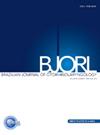环上型喉部分切除术后的康复:队列研究。
IF 1.7
4区 医学
Q2 OTORHINOLARYNGOLOGY
引用次数: 0
摘要
目的评估环状喉上切除术患者的嗓音、吞咽和呼吸康复情况;评估嗓音变化的影响和整体生活质量:这是一项前瞻性队列研究,对嗓音、吞咽和呼吸康复进行评估。采用 EORTC QLQ-C30 和 H&N35 问卷评估生活质量:研究共纳入 31 名患者。70.4% 的患者为 T3。在吞咽评估中,有两名患者(6.4%)被认为未康复。10名患者(32.2%)被视为部分康复,19名患者(61.3%)被视为完全康复。灵敏度异常,为 74.2%。58.1%的患者出现穿透,29%的患者出现吸入。在语音评估中,19 名患者(61.3%)被认为已经康复。77.41%的患者经计算后认为嗓音障碍指数异常。在评估呼吸时,8 名患者(25.8%)被认为未康复。在5.77年的随访中,无病生存率为87.1%。在接受特定检查和评估时,只有 38.7% 的患者完全康复。如果将 EORTC-C30 和 H&N35 问卷的结果与参考值进行比较,本研究中患者的总体评分和领域评分以及某些症状的评分都更高:结论:环状上喉部分切除术仍是喉肿瘤患者的一种选择,尤其是晚期喉肿瘤患者,其生存率约为90%。术后生活质量会受到影响,但症状较少:证据等级:3.1级。本文章由计算机程序翻译,如有差异,请以英文原文为准。
Rehabilitation after supracricoid partial laryngectomy: cohort study
Objectives
To evaluate vocal, swallowing and respiratory rehabilitation of patients undergoing supracricoid laryngectomy; evaluate the impact of voice changes and global quality of life.
Methods
It is a prospective cohort study where voice, swallowing and respiratory rehabilitation where evaluated. Quality of life was assessed using EORTC QLQ-C30 and H&N35 questionnaires.
Results
31 patients were included in the study. 70.4% of patients were T3. In swallowing assessment, two patients (6.4%) were considered non-rehabilitated. Ten patients (32.2%) were considered partially rehabilitated and 19 (61.3%) fully rehabilitated. Sensitivity was abnormal at 74.2%. Penetration occurred in 58.1% of patients with 29% experiencing aspiration. In voice assessment, 19 (61.3%) patients were considered rehabilitated. 77.41% had a calculated voice handicap index considered abnormal. When assessing breathing, eight patients (25.8%) were considered non-rehabilitated. Disease-free survival was 87.1% in follow-up of 5.77 years. When subjected to specific exams and evaluations, only 38.7% were completely rehabilitated. When comparing results of EORTC-C30 and H&N35 questionnaires with the reference values, global score and domain scores are better on the patients of the study, as well as some of the symptoms.
Conclusion
Partial supracricoid laryngectomy remains an option in patients with laryngeal tumors, especially in the most advanced ones, with a survival rate around 90%. Quality of life is impacted after surgery, but with few symptoms.
Level of evidence
Level 3.1
求助全文
通过发布文献求助,成功后即可免费获取论文全文。
去求助
来源期刊

Brazilian Journal of Otorhinolaryngology
OTORHINOLARYNGOLOGY-
CiteScore
3.00
自引率
0.00%
发文量
205
审稿时长
4-8 weeks
期刊介绍:
Brazilian Journal of Otorhinolaryngology publishes original contributions in otolaryngology and the associated areas (cranio-maxillo-facial surgery and phoniatrics). The aim of this journal is the national and international divulgation of the scientific production interesting to the otolaryngology, as well as the discussion, in editorials, of subjects of scientific, academic and professional relevance.
The Brazilian Journal of Otorhinolaryngology is born from the Revista Brasileira de Otorrinolaringologia, of which it is the English version, created and indexed by MEDLINE in 2005. It is the official scientific publication of the Brazilian Association of Otolaryngology and Cervicofacial Surgery. Its abbreviated title is Braz J Otorhinolaryngol., which should be used in bibliographies, footnotes and bibliographical references and strips.
 求助内容:
求助内容: 应助结果提醒方式:
应助结果提醒方式:


